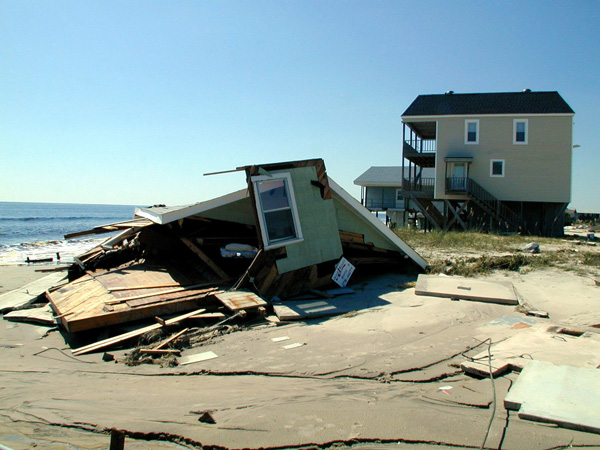 |
Homeowner Perspective. What can a hurricane do to a home? |
 |
When the force of a hurricane bears down on residential structures, homes can be ripped apart by the storm's powerful winds. Storm surge and inland flooding can also cause catastrophic damage. Overland surge and flooding may cause a building or other structure to collapse due to the hydrodynamic forces caused by the moving water, particularly when waves are present. When waves propagate and strike a building or other structure, the oscillatory currents produced can generate very strong wave loads, which are often sufficient to destroy the wall and/or foundation of a building/structure. Water weighs approximately 1,700 pounds per cubic yard, and extended pounding by frequent waves can demolish any structure not specifically designed to withstand such forces. In the absence of currents and waves, flooding is usually insufficient to cause a building to collapse, unless the flood level is greater than a couple of meters.
 David & Kimberly King's Waveland, MS house before (left) and after (right) Hurricane Katrina (2005). Both wind and storm surge caused the devastation shown. Image courtesy of David and Kimberly King. |
|
With proper design and construction, hurricane wind and flood damage to residential structures can be greatly reduced or eliminated. The scientific study of hurricane impacts on buildings and the environment has seen major advances over the years. From small-scale wind tunnel laboratories to experimental external wind devices, materials and structures have been tested and modified for better performance. In order to create full-scale realistic hurricane conditions, newer facilities have been designed and created to simulate the varying nature of the wind field, along with rains and debris, during these powerful events. High-tech facilities, such as the RenaissanceRe Wall of Wind (opened in 2007) and the more recent Institute for Business and Home Safety facility (opening soon in 2010), were designed to test full-scale residential structures and materials in a repeatable, scientifically controlled environment.
Scientists and engineers better understand how buildings fail under the force of hurricane force winds and this knowledge has enabled policy makers to develop modern building codes that lead to the construction of stronger buildings that can withstand hurricane force winds. Building codes also address flooding threats in several ways, including requiring buildings to be built above projected flood levels or requiring lower level components of buildings to break away in a flood. Currently, there is no building code for protection against flooding damage, although the American Society of Civil Engineers does have a publication that provides some empirical formulas for calculating wave loads on buildings/structures. Another ASCE publication provides guidelines for flood resistant design and construction. For further discussion on building codes please see Mitigation and Preparation to Response and Recovery.
 Hurricane Floyd (1999) brought a devastating 4.5 m (~15 ft) storm surge that damaged or destroyed hundreds of houses along Long Beach on Oak Island, NC. Here is a prime example of mitigation working- the elevated house on the right was still standing after the hurricane. The older, ground-level block foundation of the home on the left was crushed. Elevation of this home (on the right) may have prevented it from being completely destroyed. Image credit: Dave Gately/ FEMA News Photo. |
|
References
Additional Links on HSS
|
 |



